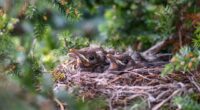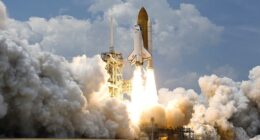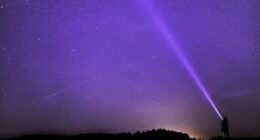Neptune and Uranus are outer planets in our solar system. Neptune is known for its deep blue color and windy atmosphere, while Uranus rotates on its side.
TL;DR Neptune Vs. Uranus
Neptune is known for its stunning deep blue color and turbulent weather patterns. It boasts the fastest winds in the solar system and has a thick atmosphere composed mainly of hydrogen, helium, and methane.
Uranus has a pale blue hue due to its high concentration of methane gas in its atmosphere. It experiences extreme seasons as it rotates on its side.
Neptune

Neptune, the eighth planet from the sun, is a fascinating celestial body that has baffled astronomers for centuries. Named after the Roman god of the sea, Neptune’s bluish hue and turbulent atmosphere give it an ethereal appearance. This gas giant boasts powerful winds reaching speeds of over 1,000 miles per hour, making it home to some of the most intense storms in our solar system.
One remarkable feature of Neptune is its Great Dark Spot—an enigmatic storm system similar to Jupiter’s famous Great Red Spot. However, unlike its crimson counterpart, this massive tempest comes and goes mysteriously. Another intriguing aspect is Neptune’s unique magnetic field orientation—it tilts at an angle of about 47 degrees relative to its axis of rotation.
Neptune also showcases stunning cloud formations that continuously evolve and morph as they travel through its atmosphere. These clouds are predominantly composed of methane gas which absorbs red light while reflecting blue light back into space—hence Neptune’s captivating azure shade.
Beyond its mesmerizing appearance lies another wonder: Triton—the largest moon orbiting Neptune. This icy satellite exhibits geysers erupting nitrogen gas into space—a phenomenon rarely observed in our solar system.
Uranus

Uranus, the seventh planet in our solar system, is a fascinating celestial body that has intrigued astronomers for centuries. Named after the Greek god of the sky, Uranus holds many secrets waiting to be discovered.
One unique feature of Uranus is its distinct blue-green color, which sets it apart from other planets. This hue is caused by its atmosphere’s composition, mainly consisting of methane gas. Additionally, Uranus has an axial tilt that defies convention – instead of standing upright like most planets, it spins on its side!
The rings surrounding Uranus are another intriguing aspect worth mentioning. While not as prominent or well-known as Saturn’s rings, they add to the planet’s allure and beauty. These rings contain varying amounts of dust and ice particles and have been observed to change over time.
In terms of size and mass, Uranus falls behind some of its counterparts in the solar system. It has a diameter four times larger than Earth but only about 14 times more massive than our home planet. Furthermore, it sits at an average distance from the sun of approximately 1.8 billion miles (2.9 billion kilometers).
Exploring this enigmatic world further may reveal even more captivating details about Uranus’ composition and history. Whether through future missions or technological advancements in telescopes here on Earth, we eagerly await new discoveries that will deepen our understanding of this mysterious planet.
Neptune Vs. Uranus – Key differences
| Aspect | Neptune | Uranus |
|---|---|---|
| Color | Deep blue appearance due to methane in its atmosphere. | Pale blue-green hue caused by methane and hydrogen. |
| Atmosphere | Prominent storms, including the Great Dark Spot. | Rapid winds and distinct cloud bands. |
| Composition | Mostly hydrogen and helium, with traces of methane. | Composed of hydrogen, helium, and methane. |
| Rotation | Rotates on its axis relatively quickly. | Unusual rotation on its side; rolls like a ball. |
| Magnetic Field | Strong magnetic field. | Tilted magnetic field. |
| Rings | Faint, dark rings. | Rings composed of dark particles and dust. |
| Moons | 14 known moons, including Triton. | 27 known moons, including Titania and Oberon. |
| Discovery Year | Discovered in 1846 by Johann Galle. | Discovered in 1781 by William Herschel. |
| Named After | Roman god of the sea. | Greek god of the sky. |
Neptune Vs. Uranus – Unique features
Neptune
- Great Dark Spot: A massive storm system similar to Jupiter’s Great Red Spot, but it was last observed in 1994 and has since disappeared.
- Triton: Its largest moon has a retrograde orbit, suggesting it may be a captured Kuiper Belt object.
- Strong Magnetic Field: One of the strongest magnetic fields among the planets, tilted relative to its rotation axis.
- Faint Rings: Neptune has a system of faint, dark rings, which were discovered by Voyager 2 in 1989.
- Discovery: Discovered in 1846 through mathematical predictions prompted by irregularities in Uranus’s orbit.
Uranus
- Extreme Tilt: Uranus rotates on its side, with its axis almost parallel to its orbital plane, causing extreme seasonal variations.
- Rings: Has a system of narrow, dark rings composed of small particles, discovered during a stellar occultation in 1977.
- Moon Characteristics: Moons such as Miranda exhibit unique geological features, including varied terrain and large cliffs.
- Tilted Magnetic Field: Uranus’s magnetic field is tilted at an angle of about 60 degrees from its rotation axis.
- Discovery: Discovered in 1781 by William Herschel, leading to the first new planet discovery with a telescope.
Neptune Vs. Uranus – Differences in Size, Mass, and Distance from the sun
| Property | Neptune | Uranus |
|---|---|---|
| Diameter (km) | 49,244 | 50,724 |
| Mass (kg) | 1.024 × 10^26 | 8.681 × 10^25 |
| Distance from Sun (average, million km) | 4,498.4 | 2,870.99 |
These values provide a basic comparison of size, mass, and average distance from the Sun for Neptune and Uranus. Neptune is slightly smaller than Uranus but has a greater mass. In terms of distance from the Sun, Neptune is farther away compared to Uranus.
Image Credits
Featured Image By – Alan Dobson from Pixabay
Image 1 By – WikiImages from Pixabay
Image 2 By – WikiImages from Pixabay









